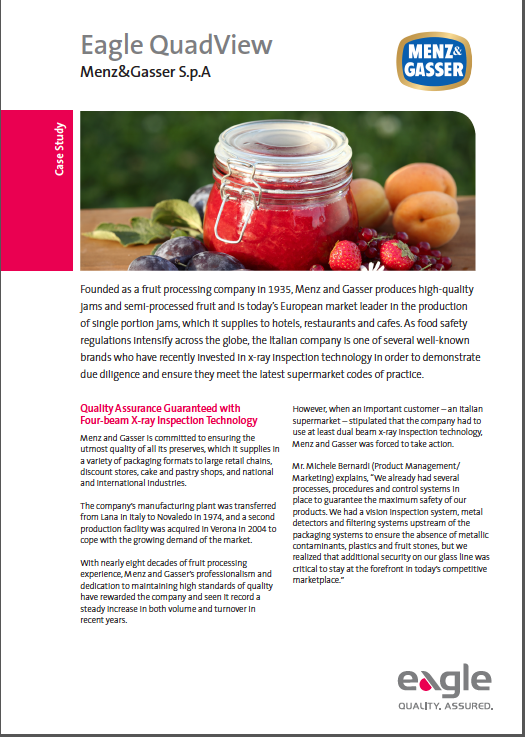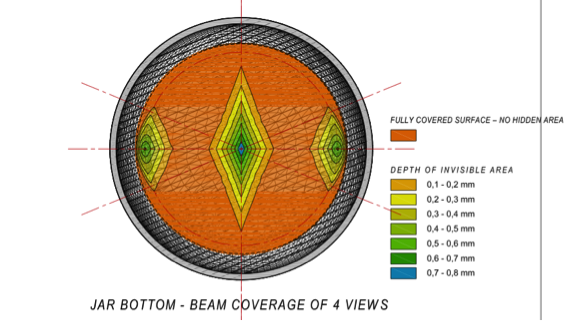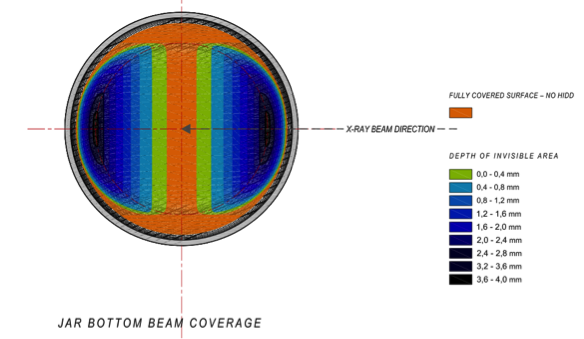 Historically, x-ray product inspection machines have been excellent at detecting foreign bodies in products, with a few notable limitations. Some of these limitations included:
Historically, x-ray product inspection machines have been excellent at detecting foreign bodies in products, with a few notable limitations. Some of these limitations included:
- Viewing Angle. Older x-ray inspection machines relied on a single x-ray emitter to take a snapshot of products on the line. If an especially narrow object was scanned head-on, the machine might not detect it.
- Density of Materials Being Scanned. The snapshot that an x-ray takes relies on the density of objects to create the image. Objects with a low density might not show up on the scan at all compared to the surrounding product. One example would be specks of aluminum, which might trigger a metal detector, but not an older x-ray machine. Another would be glass, which older x-ray machines had difficulty detecting.
- Interference from Product Packaging. Another side effect of the x-ray machine’s reliance on object density differences was that if the product packaging was sufficiently dense, it could interfere with the inspection machine’s ability to scan the contents. For this reason, most older x-ray machines were placed before the packaging equipment on the production line.
Some challenges, such as detecting glass contaminants inside of a glass container, seemed like they would be impossible to resolve with any kind of product inspection equipment, seeing as how both x-ray machines and metal detectors couldn’t reliably detect glass in glass.
However, things have changed since the days when product inspection x-ray machines were first introduced. There have been many new innovations, such as the introduction of material discrimination x-ray (MDX) technology, that uses a detector with a dual diode array operating on different wavelengths to detect the chemical composition of products rather than just the density of objects.
So, is glass-in-glass contaminant detection possible?
The short answer is yes. But first, why is this an issue for manufacturers?
Why Food Manufacturers Need Glass-in-Glass Detection Capability
Glass is a popular choice of container material for a number of packaged food products such as spaghetti sauce, pickles, and condiments (ketchup, mustard, steak sauce, etc.). However, with glass containers there is the potential hazard of glass shards making it into the product.
When excessive force is applied to a glass object, such as a jar, the glass breaks. Anyone who has ever dropped a common drinking glass onto a hard floor can tell you that glass, when it breaks, can send shards everywhere. Some are large and easy to spot, others very small and easy to miss, but more than able to cause injury.
If a glass jar or other glass object shatters during a mishap on the production line, how can you be sure that you’ve collected all the shards that may have their way into your product or other jars? With how small and hard to see these shards can be, it’s difficult to be sure using just manual inspection methods. So, you may end up throwing out any container that has a remote chance of being contaminated.
Furthermore, the finish of glass jars can be damaged during capping which could results in glass contaminants falling into your product.
This is why food packaging companies that work with rigid glass containers need glass-in-glass contaminant detection capability to find and eliminate contaminated containers while minimizing product waste.
Detecting Glass Contaminants in a Glass Container
Since the inception of the Quadview, which uses multiple views and angle scanning, the ability of x-ray product inspection machines to detect contaminants in solid or rigid casing has improved greatly.
Now, rather than just relying on a single grayscale image to determine the presence of a contaminant, this x-ray inspection machine scans rigid containers from four different angles, giving the machine’s analysis program a more complete assessment of the contents of the glass container than a system that only uses one or even two angles to inspect products. Not only does this improve the odds of detecting glass contaminants in a glass container, it reduces the chance of a false positive by running multiple scans.
The multiple-angle scans also allow the machine to detect glass shards or other contaminants that may have settled on the bottom of the jar, which would normally be very difficult to detect. Furthermore, using a four view X-ray system dramatically reduces the potential for a blind-spot at the bottom of the jars.
While no product inspection method will ever be perfect, with the right tools, you can greatly reduce your risk of a costly product recall.
QUADVIEW BOTTOM JAR INSPECTION | NO BLIND AREAS:

TRADITIONAL SINGLE VIEW BOTTOM JAR INSPECTION | LARGE BLIND AREAS:





